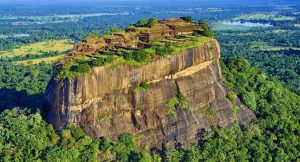Last Updated: July 25, 2019 Nidhi Singh
The Sanatan Dharma that is far from the confinement of time also boasts of timeless cosmic characters who spent a predetermined time on the face of the earth. Their sojourn on earth mostly have tales of eradication of sin, teaching and practicing benevolence, and of course helping the meek and weak. Maharishi Ved Vyas, who is credited to have compiled/edited/composed Vedas, Mahabharata, Shrimad Bhagwat Gita and all the Puranas and Mahapurans, included illustrations in his writings about these Hindu gods and goddesses that blessed the earth with their presence. Although Ved Vyas enlisted about millions of celestial beings in Hindu Sanatan Dharm, there remain some gods and goddess, who left an indelible mark on the heart of the sinful human race.
Here are some major mythological characters of Hindu Sanatan Dharma and the popular temples in India dedicated to them:
Lord Brahma

The Rig-Veda explains the concept of Brahma as a word that was used for deciphering a sacred mysterious power that helped create the world. In one amongst the many legends of Hindu Mythology, Brahma has been said to have been born of a golden egg that the Supreme Soul and Self-Existent Lord created by depositing water of the earth in a seed. Another text says that Brahma became a boar who raised the earth from the waters, and thus, created the world. He is also described as a fish or a tortoise at the beginning of the ages. Brahma is also believed to have been born from a lotus springing from the navel of another popular Hindu God, Vishnu.
Lord Brahma is said to have four faces that represent the four Vedas; and he has four hands that represent the four directions, each of the hand holds one object like a rosary (mala), a water-pot (kamandal), a book (the Vedas), and a lotus. It is believed that the rosary that he carries represent eternal time, whereas, the water-pot denotes that the world was created by water. Lord Brahma can be seen seated on a large lotus and is reckoned to use a swan as his vehicle. It is to be noted that swan is a symbol of knowledge.
Famous Brahma Temples in India: There are few temples that are dedicated to Lord Brahma in India. One temple is in Pushkar Rajasthan, others are Brahma Temple in Kumbakonam Tamil Nadu, Chaturmukha Brahma temple in Chebrolu, Andhra Pradesh, Brahmapureeswarar Temple in Thirupattur in Thiruchirapalli, Tamil Nadu and Thirunavaya in Kerala.
Lord Vishnu
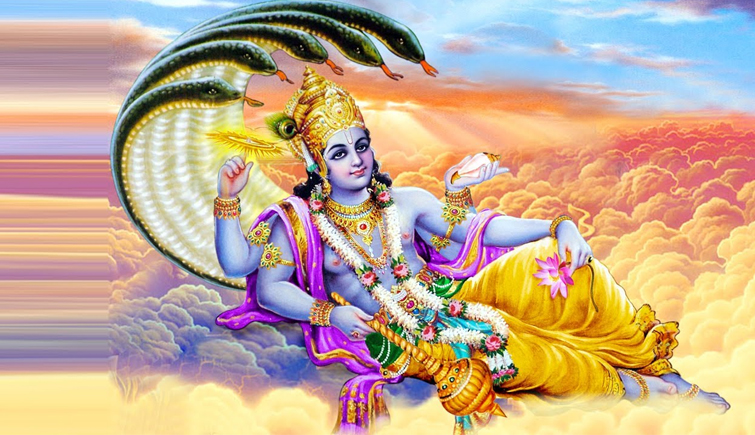
Lord Vishnu, in Hindu Mythology, is reckoned to have been vested with the quality of permanence, continuity, and preservation. In the Rig Veda, Vishnu, is associated with Sun. He is also believed to be the essential part of the Trinity, i.e. Brahma, Vishnu, Mahesh. However, he has been recognized as God with numerous incarnations including the popular ones that of Lord Rama and Lord Krishna. He also took on the attributes of several deities in varied forms of animals like fish (Matsya), tortoise (Kurma), and the boar (Varaha); and eventually these diverse elements were reduced to the group of twenty-four Vishnu incarnations. The Man-Lion (Narasimha), the Dwarf (Vamana), Parashurama, Rama and Krishna along with the aforementioned ones were the major incarnations of Lord Vishnu.
Lord Vishnu is blue in color and is believed to have four or more hands. He is dressed in yellow attire and is shown holding a wheel that represents the Universal Mind and the powers of creation and destruction; and a conch-shell, which is said to be associated with the inception of existence through its spiral form and its connection with water. This popular Hindu God is also seen holding the club which denotes authority or the strength of wisdom as the essence of life. The vehicle of Vishnu is Garuda/eagle, which is reckoned to be half-man and half-bird.
Epic: Vishnu Puran
Famous Vishnu Temples in India
- Badrinath Temple, Uttarakhand
- Ranganathaswamy Temple, Srirangam, Tamil Nadu
- Padmanabhaswamy Temple, Trivandrum, Kerala
- Venkateswara Temple, Tirumala, Andhra Pradesh
- Jagannath Temple, Puri, Odisha
- Bhadrachalam Temple, Telangana
- Koodal Azhagar Temple, Madurai, Tamil Nadu
- Vitthal Temple, Pandharpur, Maharashtra
- Sarangapani Temple, Kumbakonam, Tamil Nadu
Lord Shiva

Often associated with salvation, Lord Shiva is the part of holy Trinity of Brahma, Vishnu, Mahesh (Shiva). He is also known as the destroyer, a meditator, and is associated with austerity; the one who dwells alone in the Himalayas and in the crematory grounds. Where Lord Vishnu is believed to have manifested himself through various incarnations, God Shiva is reckoned to have shown different aspects of his own powers and that of his consort. Even though this famous Indian mythological character has a form and a shape, he is worshipped frequently in his Lingam (Phallic) form which represents the power of procreation and regeneration. Lord Shiva is multifaceted, and Aghora (in which he resides in the cremation grounds); Ishana (Shivalingam); Tat Purush (meditator), Varna Deva (eternally auspicious); Sadyajot or Braddha Rudra (old wrathful) are some of his forms. Thus he is amongst the most popular Hindu deities in India, and it is probably his mysterious and unique ways that fascinate the devotees; in fact, one can witness narration of Shivpuran Katha on a massive scale, around the globe for spiritual bliss and awareness to walk on the righteous path.
Shiva is a three-eyed God, he has long matted hair that holds holy River Ganga. On one side of his, a crescent moon is placed. He has four hands, with which he holds a triden, a ‘damru,’ an axe and an antelope. As clothes, he wraps himself in tiger skin and is often seen smeared with ash. His head, neck and arms has a snake coiled around and his throat is blue, due to drinking the poison during the churning of the ocean by the gods. He is also shown wearing a garland of skulls. His vehicle is the bull called Nandi.
Epic: Shiv Puran and Ling Puran
Important Shiva Festivals: Maha Shivratri
Famous Shiva Temples in India
- Kedarnath, Uttarakhand
- Somnath, Gujarat
- Mallikarjuna Swamy, Srisailam, Andhra Pradesh
- Mahakaleshwar, Ujjain, Madhya Pradesh
- Omkareshwar, Madhya Pradesh
- Bhimashankar, Pune, Maharashtra
- Kashi Vishwanath, Varanasi, Uttar Pradesh
- Trimbakeshwar, Trimbak, Maharashtra
- Ramanathaswamy, Tamil Nadu
Lord Shri Rama
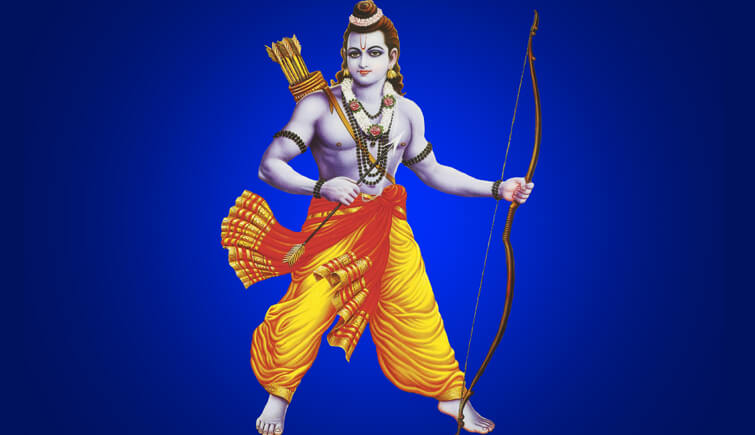
Rama literally means ‘Brahman’, someone who has supreme cosmic powers. Reckoned to be the seventh avatar/incarnation of Lord Vishnu, who marked his presence in the Treta Yuga. He is also known as Purushottam, which translates to the best of all men or Supreme Personality. Lord Rama is considered the embodiment of truth, of morality, the ideal son, husband and king. His noble character has been depicted well in the epics Ramayana by Valmiki and Ramcharitramanas by Tulsidas. In recent times, various Hindu Sansthans/Groups/Communities hold, on a large scale narration of Sri Rama Katha to instill spirituality in the masses and guide them on the path of righteousness.
In appearance, Lord Rama is said to have a dark complexion (black/blue), he has two hands, and in his right hand is a bana (arrow), while he is seen holding the Dhanush(bow) in his left hand which is bent in ‘S’ shape. At most places, Lord Rama is seen with his wife, Sita on the right side and brother, Lakshmana on the left.
Epic: Ramchatrimanas by Tulsidas and Ramayana by Valmiki.
Important Ram Festivals: Ram Navmi & Diwali
Famous Rama Temples in India
- Ram Mandir, Ayodhya, Uttar Pradesh
- Bhadrachalam Temple, Telangana
- Kodandarama Temple,Kadapa District, Andhra Pradesh
- Sree Ramaswami Temple, Thalassery, Kerala
- Ramaswamy Temple, Kumbakonam, Tamil Nadu
- Kalaram Temple, Nashik, Maharashtra
- Ram Mandir, Bhubaneshwar Odisha
- Ramchaura Mandir, Hajipur, Bihar
- Kodanda Rama Temple, Hampi, Karnataka
- Ramtek Ram Temple, Maharashtra
- Raghunath Temple, Jammu, Jammu & Kashmir
Lord Shri Krishna

The One Who Knows the Sixty-Four Arts, Lord Krishna is recognized as the eighth incarnation of Vishnu and is probably the favorite most and famous Hindu mythological character. Krishna’s journey on earth is considered an appropriate reflection of different stages of life of the human race, i.e, childhood, adolescence and adulthood, and the challenges they undergo. Although, this Vishnu’s avatar had a specific purpose to serve, but Lord Krishna’s distinct personality created a difference of opinion between two schools of thought that questioned the original relationship between these two popular Hindu Gods. There are plenty of incidents and narratives that determine the might of Lord Krishna, however, his mischiefs as a child and as an adult can make him a popular Indian mythological characters for kids. His Leelas with Gopi are well preserved in Srimad Bhagavata Mahapurana, whereas, his important life teachings can be found in the illustrious Shrimad Bhagavad Gita. In recent times, endeavors to convey knowledge of the legacy of Shri Krishna to the masses are made by organizing Shrimad Bhagwat Katha by Hindu Sansthans across the world.
Lord Krishna’s appearance is distinguished by his blue or black complexion. He is shown with two hands that are engaged in playing the flute, while he stands crossing the legs. His attire is usually colorful and richly ornamented. Sometimes, he is also illustrated as holding a conch-shell or a curved stick in his hand. Often, his consort Radha can be seen standing next to him with some cows surrounding the two. His images of dancing with the cowherd women (gopis), and as a child savoring butter and as Arjuna’s charioteer in the battlefield are also quite common.
Epic: Shrimad Bhagwat Mahapuran
Important Krishna Festival: Janmashtami
Famous Krishna Temples in India
- Dwarkadhish Temple, Dwarka Gujarat
- Guruvayur temple, Guruvayur, Kerala
- Sri Sri Radha Madan Mohan Mandir, Vrindavan, Uttar Pradesh
- Banke Bihari Temple, Vrindavan, Uttar Pradesh
- Jugal Kishore, Vrindavan, Uttar Pradesh
- Radha Raman Temple, Vrindavan, Uttar Pradesh
- Prem Mandir, Vrindavan, Uttar Pradesh
- Udupi Sri Krishna Matha, Udupi, Karnataka
- Govind Dev Ji Temple, Jaipur, Rajasthan
- Arulmigu Rajagopalaswamy Temple
- Tiruvarur, Tamil Nadu
- Shamlaji Temple, Samalaji, Gujarat
- Ambalappuzha Sri Krishna Temple, Ambalapuzha, Kerala
Goddess Durga
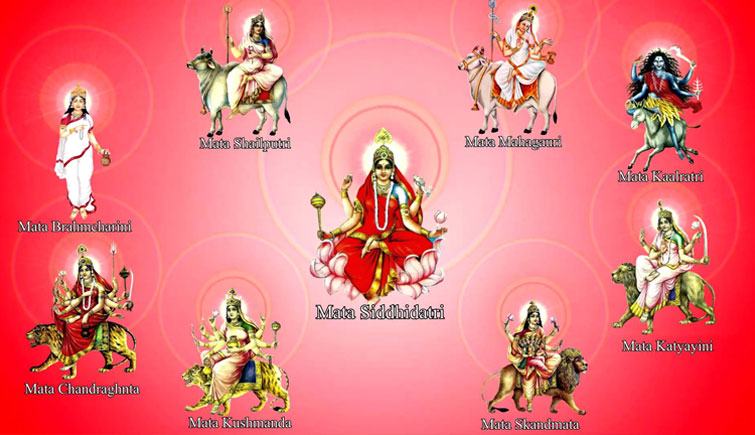
Before the cosmic creation, Goddess Durga was evoked by Lord Shiva from his left half to be the part of his Shivlok. Durga is a female energy that defeated the demon Mahishasura who was creating havoc on earth. It is believed that Goddess Durga is the same energy (ray) that came out of the mouth of Lord Vishnu and merged with rays emitted by other gods. She is a pure form of energy and is also referred to as the ‘Shakti’ of the Impersonal Absolute. This popular Hindu mythology goddess is also worshipped in 9 different avataars like that of Kushmanda, Chandraghanta, Brahmcharini, Shailputri, Skandamata, Katyayani, Kalaratri, Mahagauri, and Mahakali during the Durga Puja. Goddess Durga in Indian mythology is also believed to be the consort of Lord Shiva in the form of Parvati.
Goddess Durga has eight hands, which hold a trident, a sword, a snake, a bell, a drum, a shield, a cup, a bow, a wheel, a conch-shell, a mace, an arrow and a water pot. She is shown wearing a garland of skulls and seated in a yogic/sukhasana posture on double lotus or on a tiger/lion.
Epic: Shrimad Devi Bhagwat Mahapurana
Important Durga Festivals: Vasant Navratri, Navaratri
Famous Durga Temples in India
- Vaishno Devi Temple, Jammu, Jammu & Kashmir
- Chamunda Devi near Palampur, Himachal Pradesh
- Jwala Devi, Kangra, Himachal Pradesh
- Kalka Devi, New Delhi
- Mansa Devi Temple, Haridwar, Uttarakhand
- Durga Temple near Varanasi, Uttar Pradesh
- Devi Patan Temple in Gonda, Uttar Pradesh
- Chinese Kali Temple, Kolkata, West Bengal
- Kamakhya Temple, Guwahati, Assam
- Adhar Devi Temple, Mt Abu, Rajasthan
Goddess Lakshmi

A symbol of beauty, fertility, and auspiciousness, Goddess Lakshmi remain an important Hindu mythological character. Reckoned to be the provider of wealth, she is said to be the daughter of Sage Bhrigu and consort of Lord Vishnu. One of the mythological stories confirms that this Hindu Goddess resurrected to life during the epic churning of the ocean. An ardent devotee of Lord Shiva, the goddess is also associated with God Kuber and Indra. Her other names include Manushri, Chakrika, Kamalika, Aishwarya, Lalima, Kalyani, Nandika, Rujula, Vaishnavi, Samruddhi, Narayani, Bhargavi, Sridevi, Chanchala, Jalaja, Madhavi, Sujata, Shreya. Also, she has been referred to as Jaganmaatha or the Mother of the Universe in Shri Mahalakshmi Ashtakam.
The much revered Hindu Goddess, Lakshmi has four hands (when sown individually), however, only hands of her are shown when she with Vishnu. A lotus in each of her upper hands; gold coins dropping down from the palms of her lower two hands can be seen in many of her illustrations. She is also depicted in golden colour and seated or standing on a lotus with two elephants, partially submerged in water, one on each side.
Important Lakshmi Festivals: Vasant Navratri, Navaratri
Famous Lakshmi Temples in India
- Lakshmi Narayan Temple (Birla Mandir), Delhi
- Sripuram Golden Temple, Vellore, Tamil Nadu
- Mahalakshmi Temple, Kolhapur, Maharashtra
- Ashtalakshmi Temple, Chennai, Tamil Nadu
- Lakshmi Devi Temple, Hassan, Karnataka
- Mahalakshmi Temple, Mumbai, Maharashtra
Goddess Saraswati
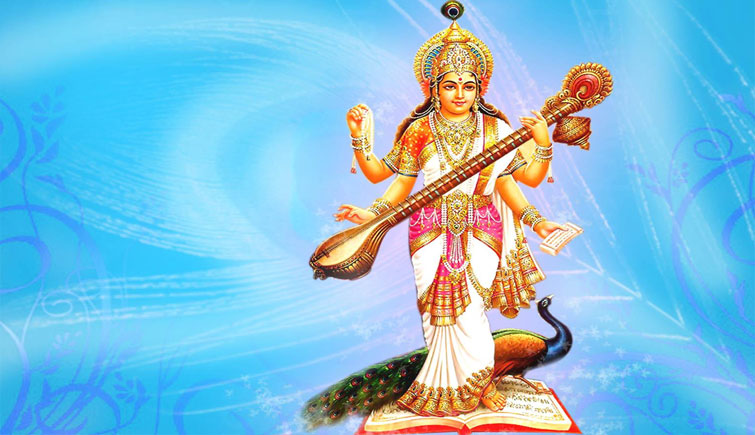
Reckoned to be the connoisseur of knowledge, music, arts, wisdom and the learning, Goddess Saraswati is an integral part of Hindu mythology and that of the sacred trinity of Lakshmi, Parvati and Saraswati. Goddess Saraswati is said to be the consort of Lord Brahma, and along with goddess Lakshmi and Parvati, she contributes in creating, maintaining and destroying the universe. In fact the trio is considered to be of great assistance to the male trinity of Brahma, Vishnu, and Mahesh. Saraswati is also considered the daughter of Lord Brahma of whom she was born out of the mouth, hence, she became the goddess of speech, music and knowledge. Although, the Vedas describe Saraswati as a river.
Goddess Saraswati’s image is of a beautiful female, who is milk white in complexion and is dressed in white saree as well. She is often shown standing/sitting on a water lily. Her illustration also displays of her with four hands, and with one of her hands she is presenting a lotus to Brahma. In another hand, she can be seen holding a book of palm leaves representing learning; while in her two left hands she has a string of pearls and a small vase. She is often shown, playing a Veena.
Famous Saraswati Festivals: Vasant Navratri, Navaratri
Famous Saraswati Temples in India
- Basara, Telangana
- Maha Saraswathi, Kaleswaram, Telangana
- Prouda Saraswathi, Kashmir (POK)
- Sarada Devi, Sringeri; Karnataka
- Saraswati in Kuthanur, Tamil Nadu
Lord Ganesha

The Remover of Obstacles, Lord Ganesha, is quite a famous Hindu deity in India, especially in Maharashtra. Considered auspicious and ideally the first God revered by the Hindu devotees while beginning a journey or initiating something new, Ganesha is also the God of wisdom, and the guardian deity. Popularly held to be the son of Lord Shiva and Goddess Parvati, Lord Ganesha has an interesting story regarding his head, which is of an elephant. The legend has it, that on refusing to let Lord Shiva meet Goddess Parvati while she was taking a bath, Shiva decapitated Ganesha in anger, and then to placate Parvati he promised to replace the head with the first thing he would find in the forest; which happened to be an elephant. Another legend reveal different aspect of the story, in which Lord Shiva after decapitating Ganesha ordered other celestial being to get the head of anything that they find at first; which again is reckoned to be an elephant. However, the legend further says that while taking off the head of the elephant’s, its tusk broke, and thus, often Ganesha is depicted with a broken tusk.
Lord Ganesha has a head of an elephant, four to ten arms, a round belly, and is usually red or yellow in colour. In his hands, a rope, an axe, a goad, a dish of sweet-balls is mostly shown. However, Ganesha has four prime manifestations and each differs from the other. According to Ganesha Puran, his manifestation of Mahakota Vinayaka has ten hands, and he is seen riding a lion. The Shri Mayuresh manifestation has him in a lighter complexion, with and riding a peacock. His Shri Gajaanana manifestation has four hands, a crimson complexion and he can be seen riding a mouse. Whereas, his Shri Dhoomraketu form has two hands, grayish complexion and his vehicle is a horse. Altogether, Lord Ganesha is believed to have 32 manifestation, of which the major ones are Vakratunda (riding a lion), Ekadanta (the one-toothed one), Mahodara, Gajaanana, Lambodara (riding on a mouse), Vikata (on a peacock), Vighnaraja (riding on the serpent Sesha), Dhoomra Varna, like Shiva, Vighnesh (remover of obstacles), Modakpriya (one who loves sweets), and Ganapati (head of the semi-divine Ganas).
Epic: Ganesh Purana
Important Ganesha Festivals: Ganesh Chaturthi, Pancha Ganapati
Famous Ganesha Temples
- Shree Siddhivinayak Temple, Mumbai, Maharashtra
- Shrimant Dagdusheth Halwai Ganpati Temple, Pune, Maharashtra
- Kanipakam Vinayaka Temple, Chittoor, Andhra Pradesh
- Manakula Vinayaka Temple, Pondicherry
- Madhur Mahaganapathi Temple, Kasargod, Kerala
- Ranthambore Ganesh Temple, Rajasthan
- Moti Dungri Ganesh Temple, Jaipur, Rajasthan
- Ganesh Tok Temple, Gangtok, Sikkim
- Ganpatipule Temple, Ratnagiri, Maharashtra
- Rockfort Ucchi Pillayar Koil Temple, Tiruchirappalli, Tamil Nadu
- Karpaga Vinayagar Temple, Pillaiyarpatti, Tamil Nadu
- Sassive Kalu & Kadale Kalu Ganesha, Hampi, Karnataka
Lord Kartikeya

Quintessentially brave, intelligent and perfection personified, Lord Kartikeya gets his share of fame and reverence mostly from South India, where he is also known by the name of Shanmukha, Murugan, Subhramaniam, Shadanan, Guha, Senthil, Saravana, Kumaraswamy and Skanda. Held to be the son of Lord Shiva and Goddess Parvati and the sibling of Lord Ganesha, this popular Hindu mythological character in South India is associated with chivalry and the destruction of negativity and demons, thus worshipping him can protect one from woes and worries.
Kartikeya is said to have six heads as Shadanan, denoting five senses and the mind. In his hand is an axe, which is called Shakti as it has been endowed with power by his mother, Parvati. Kartikeya can be seen riding on a peacock that has a serpent clutched in one of its claws.
Epic: Skand Purana
Important Kartikeya Festivals: Thaipusam (Tamil Nadu), Skanda Sashti
Famous Kartikeya Temples in India
- Kartik Swami Temle, Rudraprayag, Uttarakhand
- Palani Murugan Temple, Dindigul, Tamil Nadu
- Swamimalai Murugan Temple, Kumbakonam, Tamil Nadu
- Thiruchendur Murugan Temple, Tuticorin, Tamil Nadu
- Thirupparamkunram Murugan Temple, Tirupparankunram, Tamil Nadu
- Thiruthani Murugan Temple, Thiruttani, Tamil Nadu
- Pazhamudircholai Murugan Temple, Madurai, Tamil Nadu
Lord Hanuman

Depicted as an epitome of loyalty and unconditional devotion. He is amongst the major characters in the epic Ramayana, where is seen as a mighty and zealous warrior who helps Lord Rama to win the battle between him and Ravana. His chivalrous episodes of burning down Lanka with his tail and bringing the entire mountain from Himalaya to all the way down south determine his strong personality. He is believed to be the son of Vayu, the wind god, and Anjana, an Apsara who had transformed into a monkey due to a curse. It is also said that Lord Hanuman received the ability to fly from his father. He has also been associated with Brahmacharya/celibacy.
Lord Hanuman is shown with one head, two arms and a long tail that is looped over his head. He has a face of a monkey that is placed on a well built human body. There are other forms of Hanuman as well that include one with ten arms and five heads that of a Garuda (half man, half bird), a boar, a horse and a man-lion, representing the five most important avatars of Vishnu.
Important Hanuman Festivals: Hanuman Jayanti
Famous Hanuman Temples in India
- Sankat Mochan Hanuman Temple, Varanasi, Uttar Pradesh
- Jakhoo Temple, Shimla, Himachal Pradesh
- Mahavir Mandir, Patna, Bihar
- Shri Hanuman Temple, Jamnagar, Gujarat
- Hanuman Temple, Delhi
- Kashtbhanjan Hanuman Temple, Sarangpur, Gujarat
- Hanumandhara, Chitrakoot,Uttar Pradesh
- Salasar Hanuman Temple, Salasar, Rajasthan
- Hanuman Mandir, Allahabad,Uttar Pradesh
- Hanumangadhi, Ayodhya, Uttar Pradesh
- Bet Dwarka Hanuman Temple, Gujarat
- Balaji Hanuman Temple, Mehendipur
- Karmanghat Hanuman Temple, Telangana
- Namakkal Anjaneyar Temple, Tamil Nadu
- Camp Hanuman Temple, Ahmedabad, Gujarat
- Panchamukha Hanuman Temple in Kumbakonam
- Viswaroopa Panchmukha Anjaneyaswami, Tiruvallur
- Panchamukhi Anjaneya Temple at Mantralayam
- Panchmukhi Hanuman Temple in Mumbai
- Panchmukhi Hanuman Temple in Hyderabad
- Panchamuga Anjaneya Temple in Pondicherry
Vishwakarma
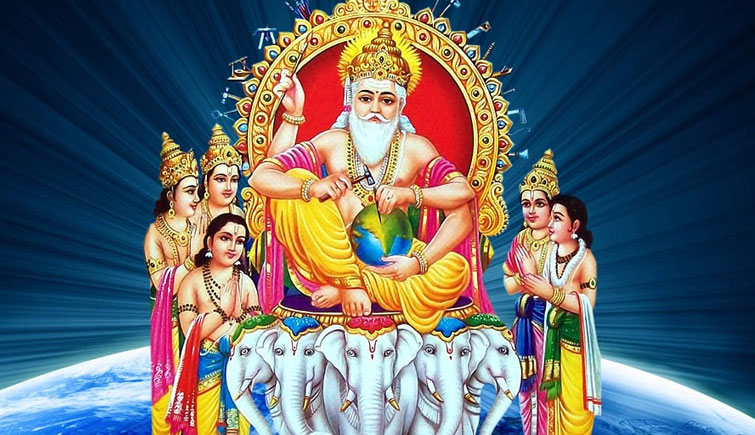
The ‘Divine Architect of the World,’ Vishwakarma is a personification of creative power in Hindu mythology. He is also reckoned to be the official craftsmen of the flying chariots and palaces of all the celestial beings. Vishwakarma is said to be the son of Brahma, and in Rig Veda, he has been described as the god with multi-dimensional vision and supreme strength. He is considered the creator of Triloka, and that of Lanka and Dwarka. Legend has it that this Hindu God also built Hastinapur and Indraprastha in the Kali Yuga, also there is a belief that the famous temple in India, Jagannath in Puri had been made by Lord Vishwakarma.
Vishkarma is seen with a bright white complexion with a club in his right hand and tools in his left hand. He has a crown on his head, a necklace of gold, and rings on his wrists. The other hands of Vishwakarma hold a water-pot, a book, a noose and craftsman’s tools.
Important Vishwakarma Festivals: Vishwakarma Jayanti
Famous Vishwakarma Temples
- Vishwakarma Prabhuji Mandir Temple, Porbandar, Gujarat
- Vishwakarma Mandir, Near Ellora Caves, Aurangabad, Maharashtra
- Vishwakarma Mandir, Phagwada, Punjab
- Vishwakarma Mandir, Nashik
- Vishwakarma Mandir, Valia, Bharuch, Gujarat
- Vishwakarma Mandir, Kathaiyya Pool, Bettiah, Bihar
- Panchmukhi Vishwakarma Mandir, Dangiyawas, Jodhpur, Rajasthan
- Shiv-Vishwakarma Mandir, Bangari, Motihari, Bihar
- Vishwakarma Mandir, Maniya Chauraha, Munger, Bihar
Goddess Parvati
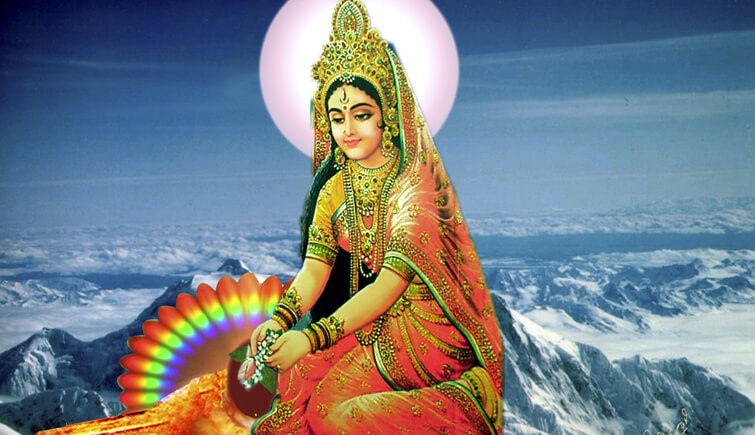
Goddess Parvati in her Durga and Kali avatar/incarnations is worshipped across India. The consort of Shiva, she is the symbol of strength, determination and devotion. She is known by different names like Lalita, Uma, Gauri, Kali, Durga, Haimavati and as the mother of the universe, she is known as Amba and Ambika. As Lalita, she represents the aspect of beauty. She is also related to fertility and is said to be the reincarnation of Sati, who Lord Shiva was married to. Goddess Parvati’s loyalty, penance, and her dedication towards her family and devotees have been considered as her highest virtues.
When shown with Lord Shiva, Goddess Parvati can be seen with two hands, the right one holding a blue lotus and the left hanging loose. However, when represented alone, this famous Hindu Goddess in India can be seen with four hands, two of which hold red and blue lotuses and the other two exhibiting the varada and Abhaya mudras.
Important Parvati Festivals: Gangaur (Rajasthan), Vasant Navratri, Gowri Habba (Karnataka), Navaratri
Famous Parvati Temples
- Parvati temple in Khajuraho, Madya Pradesh
- Garjia Devi Temple, Uttarakhand
- Sri Garbharakshambikai Temple, Thanjavur, Tamil Nadu
- Ambaji Temple at Ambaji, Gujarat
- Tiruvairanikulam Sri Parvati Temple Near Aluva, Cochin, Kerala
- Akilandeswari Temple at Thiruvanaikaval in Tamil Nadu
- Meenakshi Temple at Madurai in Tamil Nadu
- Visalakshi Temple at Banaras, Uttar Pradesh
- Kamakshi Amman Temple at Kanchipuram in Tamil Nadu
- Attukal Temple situated in Thiruvananthapuram, Kerala
Lord Surya

Reckoned to be the dispeller of darkness, healer of diseases, and illuminator of the world, God Surya remains an important character of Hindu Sanatan Dharm. Surya is known by several names like Vivasat (Brilliant), Savitr (Nourisher), Bhaskara (Light Maker), Dinakara (Daymaker), Lokacaksuh (Eye of the World), Grahraja (King of the Constellations), Sahasrakirana (of 1000 Rays). One of the legends of Hindu Sanatan Dharm claims that Surya is the son of Kashyapa (A Vedic sage) and Aditi (Infinite Heavens). It is believed that Vishwakarma made several weapons from the blazing flames of Surya like that of discus of Lord Vishnu, lance of Kartikeya, club of Kuber and trident of Lord Shiva. Surya was first mentioned in the Rig Veda and then was represented as a door relief in 2nd century BCE. He is worshipped in many forms but two of the most common forms of the deity are Arka and Mitra, where Arka is worshipped in North and Eastern India; Mitra is found mostly in Gujarat.
Surya, one of the most important deities of Vedas is shown with a lotus in each hand and seated in a chariot that is drawn across the heavens by seven horses or one horse with seven heads. He is also shown with four hands, three of which carry a wheel, a conch-shell and a lotus and the fourth in a protective mode. His chariot is seen drawn by his charioteer Aruna, the god of dawn.
Important Surya Festivals: Chhath
Famous Surya Temples
- Konark Sun Temple, Odisha
- Biranchinarayan Temple, Buguda, Odisha
- Sun Temple, Modhera, Gujarat
- Martand Sun Temple, Anantnag, Jammu & Kashmir
- Suryanar Temple, Kumbakonam, Tamil Nadu
Lord Indra
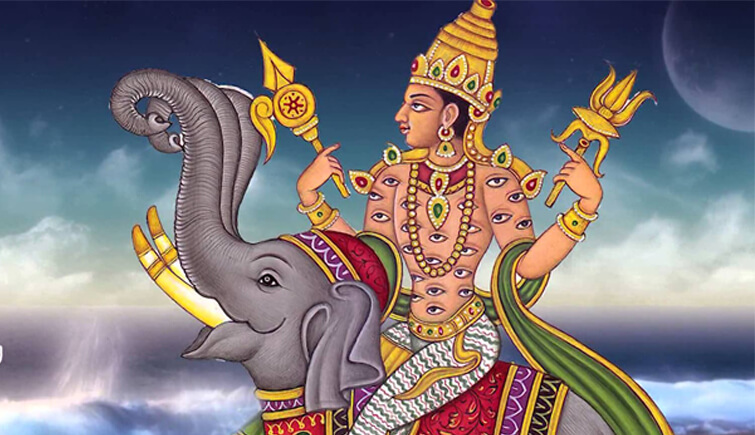
Recognized as a God of Rain and Thunder, Indra, in the Vedic period was depicted as the protector of cows and king of the Gods. He is believed to be benevolent and generous to his devotees, he is said to bless them with peace and prosperity and sending rainstorms to end droughts. Indra has also been the part of Buddhist, Cham and Chinese tradition. He is said to be have born from the mouth of the primordial god or giant Purusha who is also called the progenitor of other members of the Hindu pantheon. In Indian mythology, Indra is said to be the one fighting in the storm with the demons who try to steal the celestial cows in the form of clouds. In addition, Indra is said to have ultimate control over the universe, and that he balanced earth on his palm. He also reckoned to be the creator of rivers and streams.
Indra is shown with four hands, in one of which he holds a thunderbolt and in others a conch-shell, a bow and arrows, a hook and a net. He is sometimes shown with only two hands and eyes all over his body, and is called ‘the thousand-eyed one’. His vehicle is an elephant, Airavat, who is white in colour and has four tusks.
There are indeed several gods that are important to Hindu Sanatan Dharma but it is difficult to put them all in one blog. However, we hope you liked our effort of offering a glimpse of some of the prominent Hindu Gods. Please give it a Thumbs Up and Share it within your circle, if you appreciated our humble gesture. Also, we would be more than happy to get a feedback from you so that we can make this blog better.
We at Tour My India would also be happy to plan a pilgrimage tour for you in India. You can give us a call at 91-9212777223 or email us at info@tourmyindia.com and we shall offer the best religious tour packages at affordable rates.
Note: Although we have taken great care while including information in this blog, but it is said, ‘to err is human.’ In case you find the content of this blog erroneous, please contact us on info@tourmyindia.com with your valuable suggestion for rectification.
Published: 05 Aug, 2017
From the Lake District, Nainital, Nidhi Singh is a travel writer whose love for mountains can be seen in her write ups. Talk about solo travelling, indulging in adventure activities, binging on good food, planning budget trips or the Aurora Borealis and you will get all her attention. It is the wanderlust that keeps her going and if at all she could get one wish granted she would love to live a life less ordinary. Follow her on Twitter, Facebook & Instagram.


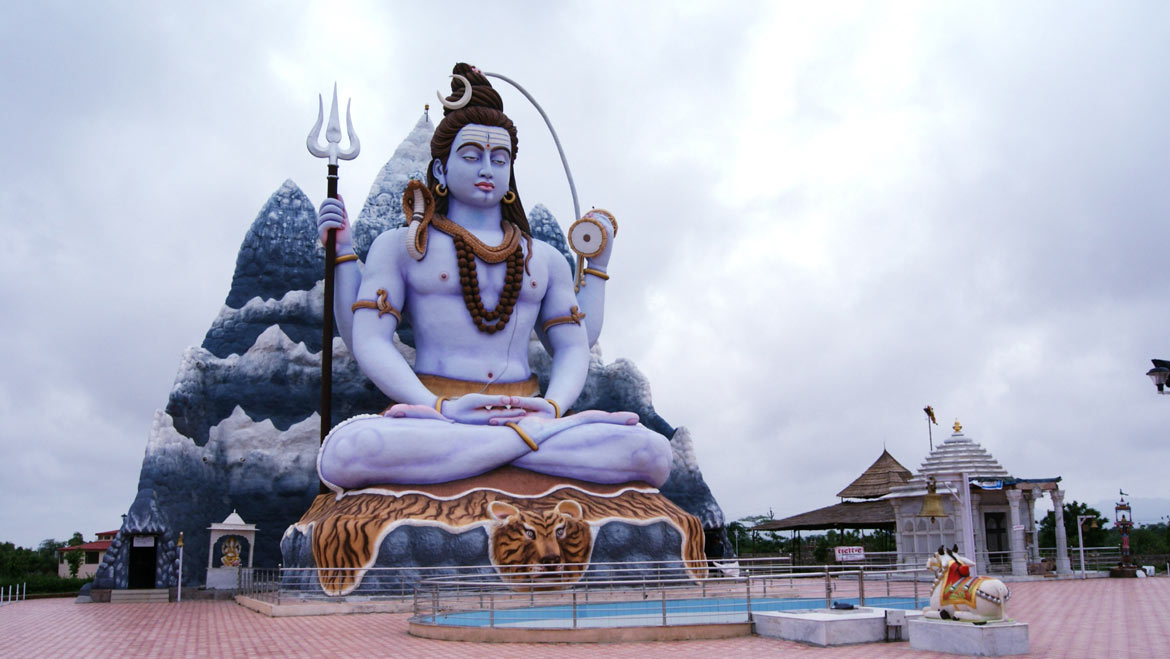
 16 Nights / 17 Days
16 Nights / 17 Days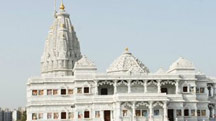 5 Nights / 6 Days
5 Nights / 6 Days 13 Nights / 14 Days
13 Nights / 14 Days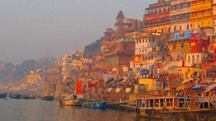 15 Nights / 16 Days
15 Nights / 16 Days




















